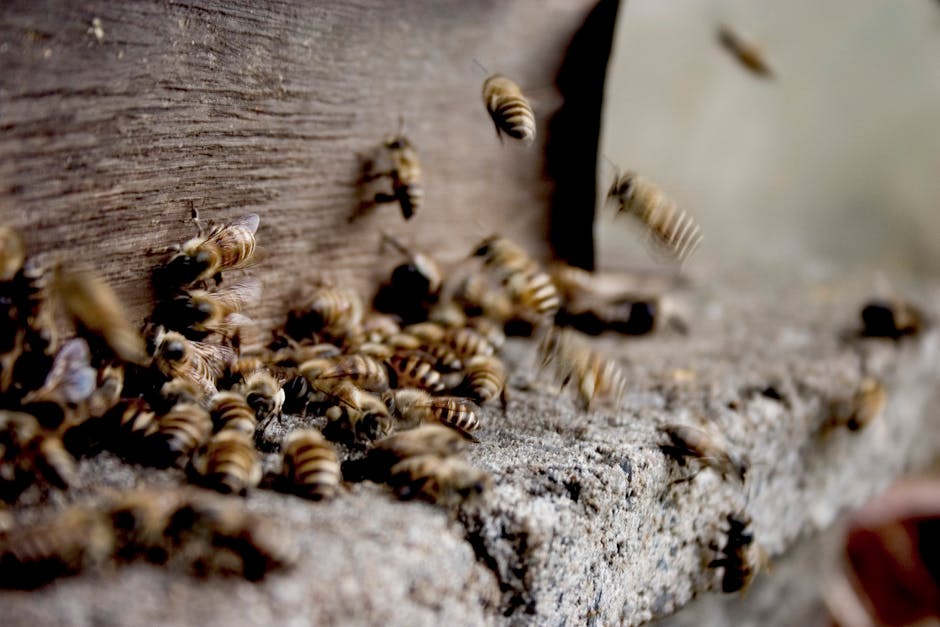Introduction to the Lifecycle of a Wasp
Understanding the lifecycle of a wasp is key to dealing with them as pests. Wasps go through four main stages: egg, larvae, pupae, and adult. The process starts when a queen lays eggs in the spring. These eggs hatch into larvae, which are fed by the workers until they pupate. After pupation, adult wasps emerge. This cycle varies slightly among different wasp species but understanding it helps in identifying the best time for control measures. For instance, targeting the nest in late spring or early summer can be more effective since it disrupts the wasp cycle early on. Remember, late summer is peak wasp activity, making control efforts more challenging. Now that you’ve got a grip on their lifecycle, you’re better equipped to tackle wasp issues head-on.
The Four Stages of a Wasp’s Life
Wasps go through four key stages in their lifecycle: egg, larva, pupa, and adult. First, the queen lays eggs. These eggs hatch into larvae, which depend on the queen for food. As they eat, they grow and eventually enter the pupa stage, cocooning themselves away. It’s in this pupa stage they transform into the adult wasps we often see buzzing around. Each of these stages plays a critical part in understanding how to manage wasp populations effectively. For instance, targeting the removal of nests early in the year can prevent the queen from laying eggs, significantly reducing future populations.
Understanding Wasp Nesting Habits
Wasps start their nest-building process early in the spring. The queen, waking from hibernation, scouts for a spot. She prefers sheltered places like eaves, attics, or even dense bushes. Using chewed-up wood mixed with saliva, she crafts the nest’s first chambers. As the weather warms, the queen lays eggs that hatch into workers. These workers take over expanding the nest, which can grow to the size of a football or larger for some species. A typical wasp nest is a marvel of engineering, complete with multiple chambers for different purposes. By understanding where and how wasps build their homes, you can better plan your approach to manage them. Keep an eye out for early signs of nest construction in the spring. If you spot them, it’s easier to deal with them before the colony grows.
Seasonal Behavior of Wasps: From Spring to Winter
As summer kicks in, wasps get busy. This is their time to shine – or terrorize, depending on how you see it. Spring starts the ball rolling. Queen wasps wake up from hibernation, scout for a spot, and build their nests. Tiny at first, these nests grow as the queen pops out more workers. These workers then take over the nest building, food hunting, and expanding their territory. Come summer, the nest is buzzing with activity. It’s all about gathering food and growing the colony. Wasps can get aggressive if they sense a threat to their home, so watch out. Autumn changes the game. The queen’s focus shifts to producing new males and future queens. These future queens will mate, find a cozy place to hibernate, and the cycle begins again in spring. Meanwhile, as winter approaches, the cold becomes too much for the wasps. Most of them, including the old queen, won’t make it. The nest is abandoned, left as a ghostly shell. Remembering these seasonal behaviors can help in planning effective wasp control strategies. Take note of when they build nests in spring and their peak in summer to target your efforts better.
Identifying Common Types of Wasps and Their Characteristics
When tackling wasps, knowing your enemy is half the battle won. There are a handful of wasp types you’re likely to encounter around your home. Let’s keep it straight to the point. Yellowjackets are the aggressive ones, wearing a signature yellow and black striped jacket, and they’re not shy about crashing your picnic. Next up, hornets, specifically the bald-faced hornet, decked out in black and white. They pack a mean sting and build large, grey, paper-like nests. Then there’s the paper wasp—slender, with a bit of an artist in them. These creatures craft umbrella-shaped nests and prefer to keep to themselves unless provoked. Identifying these wasps by their appearance and behaviors is crucial. Yellowjackets and hornets are your picnic bullies, while paper wasps are the loners but will stand their ground if disturbed. Knowing which type you’re dealing with is essential for deciding your next move in pest control. Keep it simple; look at their colors, nest types, and how they behave around your space.
Natural Predators of Wasps and the Role They Play
In the world of wasps, it’s not just humans who are fed up with them. Nature has its enforcers, ready to regulate wasp populations in your backyard. Birds like chickadees, sparrows, and starlings don’t shy away from a wasp snack when they can get it. These birds play a crucial role, patrolling your garden for these pests. Frogs and reptiles also join in. They aren’t picky eaters and will happily munch on a wasp if it crosses their path. But it’s not just about eating; some insects get in on the action too. Dragonflies are aerial allies, catching wasps mid-flight. Ever seen a spider wrestle a wasp? It happens. Spiders’ webs are wasp traps, making them unexpected heroes in controlling wasp numbers. Understand this: these natural predators are essential for keeping a balance. If you’re aiming for fewer wasps without chemicals, making your garden friendly to these critters is a smart move.
DIY Wasps Pest Control: Safe and Effective Methods
When dealing with wasp invasions, you don’t always need to call the professionals. There are safe and effective DIY methods you can try out first. Start by identifying where the wasps are nesting. Common spots include under eaves, in bushes, or even underground. Once you know where they are, choose your strategy. Water and soap solution is a surprisingly effective tactic. Mix a generous amount of dish soap with water in a spray bottle and douse the nest at night when wasps are less active. This method clogs their breathing pores and eliminates them quickly. Another method involves using essential oils like peppermint, which wasps dislike. Mix a few drops with water and spray around areas where wasps frequent. For underground nests, covering the entrance with a bowl at night can trap and eventually starve the wasps. Remember, always wear protective clothing during any DIY pest control to prevent stings. These methods can manage your wasp problem safely without immediately resorting to harsh chemicals or professional help.
Professional Wasps Pest Control Solutions
When dealing with a wasp problem, calling in professionals is often the best move. These experts have the tools, knowledge, and experience to safely remove wasps and their nests, minimizing the risk of stings or other complications. Pest control professionals can tackle wasp issues in several effective ways. First, they identify the wasp species, as different types require different strategies. For example, treating a paper wasp nest is not the same as dealing with Yellowjackets. Second, they locate all the nests. Wasps can build nests in various hidden spots, like under roof eaves or deep in bushes. Finding and removing all nests is crucial to prevent a resurgence. Third, they use specialized equipment and protective gear to safely approach and remove nests, often during the night when wasps are less active. Lastly, they provide advice on preventing future infestations, such as sealing entry points and removing potential food sources. Opting for professional pest control means you get a wasp-free home without putting yourself at risk.
Preventative Measures to Keep Wasps Away
Keeping wasps away is simpler than you might think. Start by ensuring no food is left outside. Wasps are attracted to protein-rich foods in the summer and switch their preference to sweet stuff as fall approaches. So, keep your food indoors and your trash cans sealed tight. Another trick is to limit standing water in your yard. Wasps, like many pests, need water to survive. By eliminating water sources, you reduce your yard’s appeal. Also, fix any home entry points. Wasps can sneak into homes through the smallest cracks and crevices for shelter or to build a nest. Regularly inspect and repair any gaps in window screens, door frames, and roof vents. Consider natural repellents. Certain plants like spearmint, thyme, and eucalyptus can deter wasps. Planting these around your home can keep them at a distance. Finally, mimic their territory. Wasps are territorial and avoid areas where other colonies exist. Hanging a decoy wasp nest near your home can fool wasps into thinking the area is already claimed. Stick to these steps, and you’ll significantly reduce the risk of wasp encounters.
Conclusion: Integrating Knowledge for Better Pest Management
In this guide, we’ve journeyed through the life stages of a wasp, from the founding of new colonies to the end-of-season die-offs. It’s vital to grasp this cycle for smarter pest management. Effective control means hitting them hard when they’re most vulnerable—during early spring or late winter when queens are starting their nests. Remember, timing is everything. Be proactive, not reactive. Use this knowledge to plan your attack. Less about spraying and swatting wildly, and more about strategic strikes. Got wasps setting up shop? Act fast, but think faster. You’re not just fighting the wasps you see; you’re disrupting their lifecycle. Break the cycle, and you break the problem.



